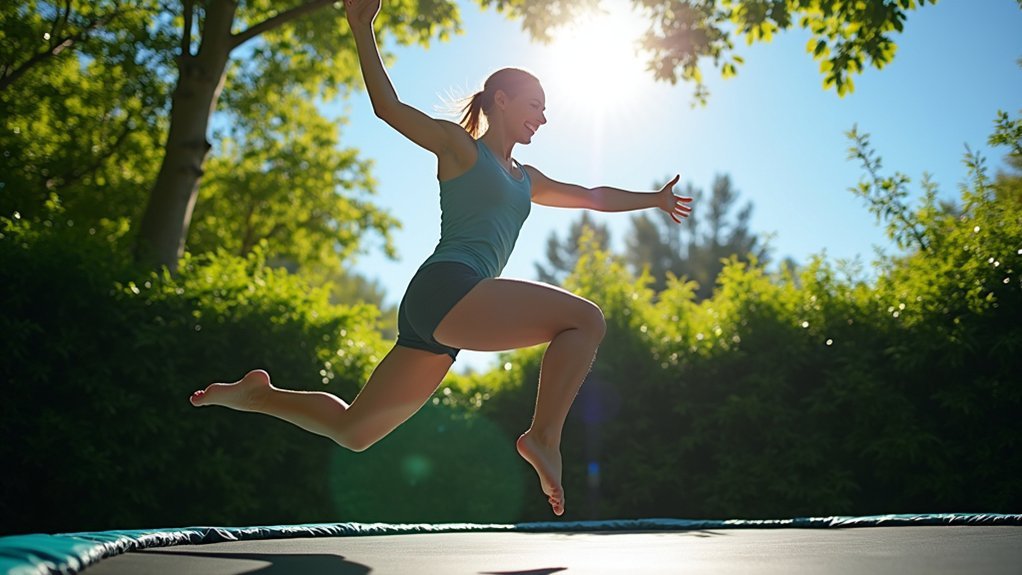Rebounding on a mini-trampoline activates your lymphatic system through gravitational changes and muscle contractions. Try the gentle “health bounce” for beginners or advanced techniques like micro-bouncing and interval protocols for deeper stimulation. Even 2-minute sessions help, while 10-15 minutes maximizes benefits. Incorporate arm movements and diaphragmatic breathing to enhance flow. Stay hydrated before and after rebounding for ideal results. Discover how consistent practice can transform your immune function and detoxification capacity.
Understanding the Lymphatic System’s Response to Rebounding

While the cardiovascular system relies on the heart to pump blood, your lymphatic system lacks a central pump, making it particularly responsive to rebounding exercises.
Unlike your heart-powered bloodstream, the pumpless lymphatic system thrives on the gentle bouncing motion of rebounding exercises.
When you bounce on a trampoline, alternating forces of acceleration and deceleration create gravitational stimulation that propels lymph fluid through vessels and nodes.
This jumping motion triggers muscle contractions that act as mini-pumps throughout your body, while the natural diaphragmatic breathing that occurs during rebounding creates negative pressure to draw lymph upward.
The mechanical stress from recurring impacts stimulates capillary action in lymph vessels, enhancing circulation. Rebounding is easier on joints than high-impact activities like running, making it accessible for individuals with arthritis while still providing lymphatic benefits. Your increased heart rate during this aerobic activity further supports lymphatic return.
This combination of mechanical forces makes rebounding uniquely effective at mobilizing stagnant lymph and activating immune response—unlike many other exercise forms.
Gentle Bounce Technique for Beginners
For individuals new to rebounding exercise, mastering the gentle bounce technique provides a foundation for effective lymphatic stimulation.
Begin with the “health bounce” – small, controlled micro-movements where your feet remain in contact with the mat while your body gently oscillates. This low-impact motion activates lymphatic vessels without stressing your joints.
Start by holding a doorway or chair for stability as you perform alternating heel lifts, creating a gentle pumping action. Keep your posture relaxed and synchronize your breathing with each movement to enhance drainage efficiency. This technique encourages lymph fluid movement from swollen tissues toward lymph nodes.
Begin with just 1-2 minute sessions twice daily, gradually working up to 10-15 minute intervals.
Always prioritize consistency over intensity, and remember that multiple short sessions are more beneficial than one extended workout for ideal lymphatic benefits.
Advanced Lymph-Pumping Jump Patterns

Ready to intensify your lymphatic flow?
You’ll maximize circulation with vertical techniques like rapid micro-bouncing and high knee lifts that create powerful gravitational shifts through your lymphatic system.
For ideal results, incorporate interval rebound protocols with amplitude variations, then challenge yourself further with multi-directional patterns that engage lymph nodes across different planes of movement. Gentle yet consistent rebounding exercises promote effective lymphatic drainage while supporting overall immune function.
Vertical Lymph Activation Techniques
When you’ve mastered basic rebounding, these advanced vertical lymph activation techniques can dramatically accelerate lymphatic circulation.
Try high-intensity split jumps with resistance, incorporating biceps curls during foot switches to mobilize upper-limb lymph flow. The vertical motion aspect makes this exercise significantly more effective for lymphatic system stimulation than horizontal exercises.
Cross-pattern rebounding drills using lateral leg crosses with opposing arm movements promote contralateral lymph flow through diagonal patterns.
For enhanced thoracic duct activation, incorporate rotational jump series that stimulate para-aortic lymph nodes through spinal twisting.
Monster jumps create hydraulic pressure differentials across lymph nodes, while their plyometric contractions generate a suction-pump effect on deep vessels.
For peak benefit, cycle through these patterns sequentially, alternating between limb-focused and trunk-focused movements.
Synchronize your breathing with movement to leverage diaphragmatic motion for ideal cisterna chyli drainage.
Interval Rebound Protocol
The Interval Rebound Protocol elevates lymphatic circulation beyond basic rebounding through strategically timed jump patterns and rest periods.
You’ll maximize lymphatic benefits by alternating 45 seconds of gentle, consistent bouncing with 15 seconds of rest, creating an efficient pumping effect throughout your system.
Incorporate advanced jump patterns by raising your arms overhead to enhance upper body drainage or adding side-to-side movements to stimulate different lymph pathways.
During your 10-15 minute sessions, target specific lymph nodes by including shoulder rolls and varied footwork. Physical therapist Kelly recommends incorporating twisted side jumps that engage your obliques and core for improved lymphatic control and circulation.
If you’re a beginner, start with 30-second intervals of equal activity and rest.
Remember to maintain proper posture and include deep breathing during rest periods to further support lymphatic flow.
This structured approach delivers superior results compared to continuous bouncing.
Multi-Directional Bounce Patterns
Unlike basic rebounding, multi-directional bounce patterns maximize lymphatic circulation by engaging your entire lymphatic system through varied movement planes.
These advanced patterns incorporate side-to-side movements, rotational jumps, and varying heights to stimulate lymph nodes throughout your body.
When you perform these diverse movements, you’re creating a powerful pumping effect that opens and closes lymphatic valves more effectively than one-dimensional bouncing.
The quick gravity changes expand your lymphatic vessels, potentially increasing lymph flow considerably.
For ideal results, mix high and low-intensity jumps while incorporating rotational movements. Despite marketing claims, scientific evidence does not support that trampolining is necessary for lymphatic health as the body’s detoxification systems function adequately without it.
You’ll not only enhance lymphatic activation but also improve balance and muscle engagement simultaneously.
Remember to include rest periods between sets and follow safety guidelines to prevent injury while enjoying these advanced techniques that clean toxins from your system.
The Science Behind G-Force and Lymph Movement

During a trampoline session, your body experiences a fascinating physical phenomenon that may benefit your lymphatic system. When you bounce, your body alternates between weightlessness and increased gravitational forces (0-3G), creating pressure differentials across your lymphatic vessels.
Unlike your circulatory system, lymph lacks a central pump, relying instead on movement and muscle contractions to flow properly. The rapid changes in gravity on a mini trampoline create a twice gravity force that generates more effective lymphatic stimulation than many other exercises.
- Feel the rhythmic compression and expansion of tissues with each bounce, potentially enhancing natural lymph propulsion
- Experience the gentle opening and closing of lymphatic valves as your body responds to changing G-forces
- Discover how your body’s waste removal system may become more efficient through consistent rebounding
- Enjoy the satisfaction of engaging a biological process that’s often overlooked in conventional exercise
- Appreciate the low-impact nature that protects your joints while still activating lymphatic movement
Optimal Rebounding Duration for Detoxification
You’ll find ideal detoxification benefits from rebounding sessions of 10-15 minutes, though even brief two-minute bounces can trigger significant lymphatic cleansing.
For maximum results, you can split your rebounding into multiple short sessions throughout the day, alternating between gentle continuous bouncing and interval-based higher intensity movements. During these sessions, your white blood cell count triples in number, enhancing your body’s natural defense mechanisms.
Your lymphatic system continues its cleansing response after you’ve finished exercising, making consistent 3-5 times weekly practice more valuable than occasional longer sessions.
Time-Based Rebounding Protocols
While many exercise programs emphasize long durations for cardiovascular benefit, rebounding for lymphatic detoxification follows different timing principles. Your lymphatic system responds remarkably quickly to gentle bouncing—just 2 minutes can flush the entire system, while 10-15 minutes creates an ideal pumping effect.
For chronic congestion, aim for daily sessions, but 3-5 times weekly suffices for maintenance. Unlike the cardiovascular system, the lymphatic system lacks a pump and relies entirely on physical movement to circulate properly.
- Feel your body releasing stagnant toxins with just 5 minutes of gentle bouncing
- Experience the surge of renewed energy as your lymph flow increases 15-30 times
- Celebrate your progress as you gradually increase from 2-minute beginner sessions
- Embrace the freedom of flexible scheduling with multiple short sessions throughout your day
- Trust the process—consistency matters more than lengthy sessions
Interval vs. Continuous Bouncing
Although both interval and continuous bouncing offer lymphatic benefits, they stimulate your system in distinctly different ways.
Interval rebounding creates repeated acceleration-deceleration cycles, potentially enhancing lymphatic pumping through multiple gravitational stress peaks. These short bursts followed by rest may improve the opening and closing of lymphatic valves.
Continuous bouncing, however, maintains steady rhythmic pressure changes that sustain consistent fluid movement. This creates a constant gentle impact that keeps lymph flowing without interruption.
While NASA research demonstrated rebounding generates higher G-forces than running, no direct comparative studies exist on which approach better activates lymphatic circulation.
For best results, consider incorporating both methods: use continuous bouncing for baseline stimulation and interval protocols when seeking more intensive detoxification benefits.
Post-Exercise Lymphatic Response
The body’s response to rebounding continues well after you step off the trampoline, initiating a cascade of lymphatic activity that forms the foundation of its detoxification benefits.
Your lymphatic system works hardest during the recovery phase, with improved circulation persisting for hours after your session ends. Studies suggest that rebounding can stimulate lymph flow up to 15 times more than normal resting levels.
- Feel renewed energy as toxic buildup clears from your tissues through activated lymphatic pathways
- Experience reduced inflammation as interstitial fluid moves more efficiently through your system
- Notice decreased swelling in extremities as proper fluid balance restores across your body
- Enjoy enhanced immunity through increased lymphocyte activity and waste removal
- Sense your body’s natural detoxification as improved circulation carries metabolic waste away
For ideal results, consistent 10-15 minute daily sessions outperform sporadic longer workouts, especially when performed in the morning.
Health-Boosting Trampoline Circuit Sequences
Designing strategic trampoline circuits can transform your lymphatic health through methodical movement patterns that maximize drainage efficiency.
Strategic trampoline movements create methodical pathways for optimal lymphatic drainage and enhanced immune function.
Begin with a 5-minute gentle bounce warm-up, then alternate 30 seconds of pike jumps with 60 seconds of controlled 1-2 inch bounces.
Add arm pumping movements to target axillary nodes while performing lateral side-to-side hops for parasternal stimulation.
Incorporate figure-8 patterns and diagonal bounds to engage multiple lymph chains simultaneously.
During your 10-15 minute session, mix in torso twists to activate your thoracic duct and leg abductions to stimulate inguinal nodes. This technique is particularly effective because rebounding increases lymphatic flow by up to 15 times compared to being sedentary.
Finish with a 3-minute cool-down of alternating heel lifts to prevent fluid pooling.
Stay hydrated with 500ml water before and after to optimize lymph viscosity.
Perform this circuit 3-4 times weekly for measurable immune circulation benefits.
Combining Deep Breathing With Bounce Techniques
Maximizing lymphatic flow requires more than just bouncing sequences—proper breathing technique multiplies your trampoline benefits exponentially.
The key lies in diaphragmatic breathing synchronized with your bounce rhythm, particularly exhaling during upward motion to enhance thoracic duct activation. As you descend, inhale deeply to create negative pressure that primes abdominal lymph nodes. Jumping on a trampoline can increase lymph flow by up to 15 times compared to when the body is at rest.
- Feel the powerful pressure shifts as your breath and bounce align in perfect harmony
- Experience the rush of renewed energy as stagnant fluids begin flowing freely
- Discover the satisfaction of mastering the “4-count” breathing technique that transforms simple bouncing into therapeutic movement
- Sense blocked pathways opening with each coordinated breath-bounce cycle
- Marvel at how your body responds when morning sessions flush out overnight fluid buildup
Upper Body Movements to Enhance Lymphatic Flow
While bouncing on your trampoline creates a powerful foundation for lymphatic movement, incorporating strategic upper body movements dramatically amplifies circulation through key drainage pathways.
Try rhythmic arm raises synchronized with your breathing to activate axillary lymph nodes and thoracic ducts. Figure-eight arm circles generate centrifugal force that propels lymph through subclavian vessels, especially when you vary your speed.
Harmonize your bounce with deliberate arm movements to unlock lymphatic pathways and amplify your body’s natural cleansing rhythm.
Crossbody elbow pulls create torsional pressure that mobilizes cervical lymph, while shoulder shrugs with micro-bounces compress supraclavicular lymph basins.
Don’t overlook your wrists – rapid flexion/extension movements stimulate hand lymphatics.
These movements are particularly beneficial since they target lymph nodes below the breasts, which are particularly important for overall lymphatic health.
For maximum benefit, alternate between these movements during your rebounding sessions. The combination of vertical bouncing with these upper body techniques creates an all-encompassing approach to lymphatic cleansing throughout your entire system.
Recovery and Hydration Strategies for Maximum Benefits
The benefits of your trampoline workout extend well beyond the final bounce, especially when you implement proper recovery and hydration protocols.
Drink 16-20 oz of water two hours before rebounding to optimize lymphatic fluid viscosity. After your session, dedicate 5-10 minutes to low-intensity bouncing as a shift to resting circulation, followed by stretches targeting major lymph node regions. Performing these exercises several times weekly can help maintain consistent lymphatic stimulation for optimal health benefits.
- Your body’s lymphatic highways need proper fluids to transport waste effectively
- Sleeping on your left side unlocks natural drainage through the thoracic duct
- Compression garments worn post-workout accelerate recovery by enhancing fluid return
- Antioxidant-rich berries combat cellular damage that hampers lymphatic function
- Foam rolling at 2-4 Hz mimics professional lymphatic massage techniques
Tracking Your Lymphatic Health Improvements
Tracking your lymphatic improvements requires both objective measurements and subjective awareness of your body’s responses.
You’ll want to establish baseline metrics like lymphatic flow rates, single-leg balance times, and white blood cell counts before beginning your trampoline routine.
As you progress, monitor detoxification symptoms like changes in energy levels, reduced swelling, and improved recovery times—all indicators that your lymphatic system is functioning more efficiently.
Lymphatic Health Tracking Subheadings
How do you know if your trampoline efforts are actually improving your lymphatic circulation? Modern tracking methods can validate your progress through scientific measurement.
Near-infrared imaging with ICG dye can visualize your superficial lymphatic vessels, while lymphoscintigraphy uses radioactive tracers to detect blockages and measure drainage velocity. Maintaining proper lymphatic flow helps prevent lymphedema development, which can lead to disabling tissue swelling if left untreated.
- See your progress – Compare pre/post-therapy images showing improved lymphatic flow after consistent rebounding
- Feel the difference – Match your subjective feelings of lightness with actual lymphographic congestion reduction
- Track your protection – Document fewer infection episodes as your lymphatic transport function improves
- Measure real results – Correlate decreased limb volume with enhanced drainage rates from rebounding
- Validate your routine – Confirm that your specific rebounding techniques actually enhance lymphangiomotor activity
Monitor Physical Response Changes
While advanced diagnostic techniques provide clinical validation, you’ll notice significant physical indicators that reveal your lymphatic system’s improving function during a consistent rebounding practice. Your body communicates these changes through observable metrics and sensations.
| Indicator | What to Monitor | Timeframe |
|---|---|---|
| Energy Levels | Morning alertness, afternoon slumps | 1-2 weeks |
| Recovery Time | Post-workout soreness duration | 2-3 weeks |
| Circulation | Extremity temperature, coloration | 3-4 weeks |
| Immune Function | Frequency of illness, recovery speed | 4-8 weeks |
Track these changes systematically. Notice how your cardiovascular indicators improve—resting heart rate typically decreases while stamina increases. You’ll likely experience enhanced balance and coordination, reduced joint pain, and improved respiratory capacity. These observable changes confirm your lymphatic system’s activation through regular trampoline exercises.
Track Detox Symptoms
As your lymphatic system begins to function more efficiently through regular rebounding, your body will exhibit various detoxification signals worth documenting.
Keep a simple journal tracking changes over 4-6 weeks to validate your progress and maintain motivation.
- Notice your rings fitting more loosely as finger and facial puffiness diminishes – visible proof your lymph is moving!
- Feel renewed mental clarity and energy surges as inflammatory waste products clear from your system.
- Experience fewer skin breakouts as toxins find proper exit routes rather than pushing through pores.
- Celebrate more regular bathroom visits as your body’s waste elimination pathways optimize.
- Observe how minor joint discomfort fades when lymphatic circulation removes inflammatory compounds.
For objective measurement, consider baseline and monthly bioimpedance scans to quantify your fluid balance improvements.
Incorporating Rebounding Into Your Wellness Routine
Since the lymphatic system lacks its own pump mechanism, rebounding offers an effective method to stimulate lymphatic circulation through controlled movement.
Begin by integrating 10-minute sessions 3-5 times weekly, starting with just 2-3 minutes if you’re new to the practice.
Start small, grow gradually—your lymphatic system responds to consistency rather than intensity.
For ideal results, pair your rebounding with deep breathing exercises that enhance thoracic drainage. Schedule morning sessions to align with natural lymph flow peaks, and always hydrate before and after to maintain proper lymph viscosity.
Consider complementary practices like dry brushing beforehand to prime superficial pathways.
Track your progress through energy levels and skin texture improvements rather than arbitrary metrics.
Alternating rebounding with yoga or similar practices creates a thorough approach to lymphatic health while managing stress that can impede circulation.
Frequently Asked Questions
Can Rebounding Help With Specific Lymphatic Disorders or Conditions?
Yes, you’ll benefit from rebounding if you have lymphedema, post-surgical swelling, or chronic inflammation. It’s particularly effective for preventing fluid buildup, supporting post-cancer recovery, and managing obesity-related edema when done consistently.
Are Mini-Trampolines or Full-Sized Trampolines Better for Lymphatic Activation?
Mini-trampolines are better for lymphatic activation due to gentler impact, controlled bouncing, and established clinical protocols. You’ll benefit from their portability, accessibility, and focused low-intensity workouts that effectively stimulate lymph flow without excessive strain.
How Does Age Affect Lymphatic Benefits From Trampoline Exercise?
As you age, your lymphatic system slows down naturally. You’ll still benefit from rebounding, but you should use gentler bounces, shorter sessions (10-15 minutes), and consider trampolines with handlebars for safety.
Can Trampoline Exercise Replace Manual Lymphatic Drainage Therapy?
No, trampoline exercise can’t completely replace manual lymphatic drainage therapy. You’ll get lymphatic benefits from bouncing, but it works differently than hands-on techniques that target specific blockages professional therapists can address.
Do Weighted Vests Enhance Lymphatic Benefits During Rebounding Sessions?
While weighted vests may increase muscle engagement during rebounding, there’s limited research on their lymphatic benefits. You’ll likely get adequate lymphatic stimulation without them, and should start with unweighted sessions for safety.
In Summary
You’ve now discovered the most effective trampoline methods for boosting your lymphatic circulation. By incorporating gentle bounces, targeted jump patterns, and upper body movements into your rebounding routine, you’ll maximize detoxification benefits. Remember to stay hydrated, track your progress, and maintain consistency. Even short sessions create significant lymphatic flow improvements. Make rebounding a regular part of your wellness practice to support your body’s natural cleansing systems.





Leave a Reply